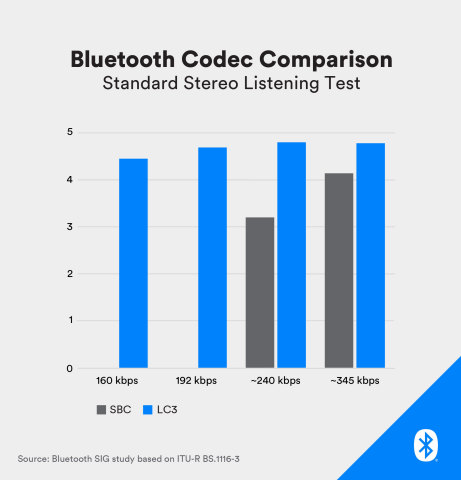LAS VEGAS--(BUSINESS WIRE)--Twenty years ago, Bluetooth® cut the audio cord and created the wireless audio market. Today, the Bluetooth Special Interest Group (SIG) announced the upcoming release of LE Audio, the next generation of Bluetooth audio. Not only will LE Audio enhance Bluetooth audio performance, it will add support for hearing aids and enable Audio Sharing, an entirely new use case that is poised to once again transform the way we experience audio and connect with the world around us.
“With close to one billion Bluetooth audio products shipped last year, wireless audio is the largest Bluetooth market,” said Mark Powell, CEO of the Bluetooth SIG. “The launch of LE Audio is a prime example of how the Bluetooth community is driving technology and product innovation and enabling delivery of even better and more capable Bluetooth audio products.”
Bluetooth audio will soon support two operation modes. LE Audio will operate on the Bluetooth Low Energy (LE) radio while Classic Audio operates on the Bluetooth Classic radio (BR/EDR). LE Audio will support development of the same audio products and use cases as Classic Audio, while introducing new features to improve their performance as well as enable new ones.
-
Low Complexity Communication Codec (LC3) for Higher Quality and
Lower Power. LE Audio will include a new high-quality, low-power
audio codec. Providing high quality even at low data rates, LC3 will
bring tremendous flexibility to developers, allowing them to make
better design tradeoffs between key product attributes such as audio
quality and power consumption.
“Extensive listening tests have shown that LC3 will provide improvements in audio quality over the SBC codec included with Classic Audio, even at a 50% lower bit rate,” said Manfred Lutzky, Head of Audio for Communications at Fraunhofer IIS. “Developers will be able to leverage this power savings to create products that can provide longer battery life or, in cases where current battery life is enough, reduce the form factor by using a smaller battery.”
-
Multi-Stream Audio for Better Performing Earbuds. Multi-Stream
Audio will enable the transmission of multiple, independent,
synchronized audio streams between an audio source device, such as a
smartphone, and one or more audio sink devices.
“Developers will be able to use the Multi-Stream Audio feature to improve the performance of products like truly wireless earbuds,” said Nick Hunn, CTO of WiFore Consulting and Chair of the Bluetooth SIG Hearing Aid Working Group. “For example, they can provide a better stereo imaging experience, make the use of voice assistant services more seamless, and make switching between multiple audio source devices smoother.”
-
Bluetooth Hearing Aids for People with Hearing Loss. Building
on its low power, high quality, and multi-stream capabilities, LE
Audio adds support for hearing aids. Bluetooth audio has brought
significant benefits to a large percentage of the global population,
with wireless calling, listening, and watching. LE Audio will enable
the development of Bluetooth hearing aids that bring all the benefits
of Bluetooth audio to the growing number of people with hearing loss.
“LE Audio will be one of the most significant advances for users of hearing aids and hearing implants,” said Stefan Zimmer, Secretary General of EHIMA, the European Hearing Instrument Manufacturers Association. “EHIMA engineers have contributed their specialist knowledge to improve the audio experience especially for hard of hearing people. As a result, within a few years most new phones and TVs will be equally accessible to users with hearing loss.”
-
Broadcast Audio for Audio Sharing. LE Audio will also add
Broadcast Audio, enabling an audio source device to broadcast one or
more audio streams to an unlimited number of audio sink devices.
Broadcast Audio opens significant new opportunities for innovation,
including the enablement of a new Bluetooth use case, Audio Sharing.
Bluetooth Audio Sharing can be personal or location-based. With personal Audio Sharing, people will be able to share their Bluetooth audio experience with others around them; for example, sharing music from a smartphone with family and friends. With location-based Audio Sharing, public venues such as airports, bars, gyms, cinemas, and conference centers can now share Bluetooth audio that augments the visitor experience.
“Location-based Audio Sharing holds the potential to change the way we experience the world around us,” said Peter Liu of Bose Corporation and member of the Bluetooth SIG Board of Directors. “For example, people will be able to select the audio being broadcast by silent TVs in public venues, and places like theaters and lecture halls will be able to share audio to assist visitors with hearing loss as well as provide audio in multiple languages.”
Availability and More Information
The Bluetooth specifications that define LE Audio are expected to be released throughout the first half of 2020. For information on LE Audio, visit: https://www.bluetooth.com/leaudio.
About the Bluetooth SIG
Formed in 1998, the Bluetooth SIG is the not-for-profit trade association that oversees Bluetooth® technology. In support of more than 35,000 member companies, the Bluetooth SIG facilitates the collaboration of its members to create new and enhanced specifications that expand the technology, drives global interoperability via a world-class product qualification program, and grows the brand by increasing the awareness, understanding, and adoption of Bluetooth technology.
About Bluetooth Technology
With close to 4 billion products shipping per year, Bluetooth technology is the global standard for simple, secure wireless connections. Since its formation in 1998, the Bluetooth community has continued to expand the capabilities of Bluetooth — powering innovation, creating new markets, and redefining communication worldwide. Today, Bluetooth is the wireless technology of choice for developers in many solution areas, including audio streaming, data transfer, location services, and large-scale device networks.





